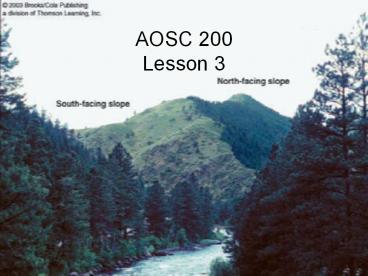AOSC 200 Lesson 3 - PowerPoint PPT Presentation
Title:
AOSC 200 Lesson 3
Description:
AOSC 200 Lesson 3 Lapse Rates and Stability Lapse rate is the rate at which the real atmosphere falls off with altitude the environmental lapse rate An average ... – PowerPoint PPT presentation
Number of Views:104
Avg rating:3.0/5.0
Title: AOSC 200 Lesson 3
1
AOSC 200Lesson 3
2
Fig. 3-1, p. 54
3
Diurnal temperature cycle
Fig. 3-3, p. 56
4
Air temperature data
- Daily mean temperature is determined by two
methods, (a) average of 24 hourly measurements
(b) the average of the maximum and minimum
temperatures for the day. - Daily temperature range is the difference
between the max and min temperatures. - Monthly mean temperature is obtained from the
average of the daily mean for the month - Annual mean temperature is the average of the
monthly means - Annual temperature range is the difference
between the coldest monthly mean and the warmest
monthly mean
5
CONTROLS OF TEMPERATURE
- LATITUDE
- SURFACE TYPE
- ELEVATION AND ASPECT
- DIFFERENTIAL HEATING OF LAND AND WATER.
- OCEAN CURRENTS.
- CLOUD COVER AND ALBEDO
6
Fig. 3-4, p. 57
7
Fig. 3-5, p. 57
8
Fig. 3-6, p. 58
9
Fig. 3-7, p. 59
10
The effect of Aspect
Fig. 3.8
11
Fig. 3-9, p. 60
12
Differential Heating of Land and Water
- AS WATER IS HEATED CONVECTION DISTRIBUTES THE
HEAT THROUGH A LARGE MASS. - IN CONTRAST, HEAT DOES NOT PENETRATE DEEPLY INTO
SOIL OR ROCK - HEAT CAN ONLY BE TRANSFERRED BY
CONDUCTION. - NET RESULT IS THAT A RELATIVELY THICK LAYER OF
WATER IS HEATED TO MODERATE TEMPERATURES, WHILE
ONLY A THIN LAYER OF LAND IS HEATED TO MUCH
HIGHER TEMPERATURES. - SPECIFIC HEAT (AMOUNT OF HEAT NEEDED TO RAISE THE
TEMPERATURE OF ONE GRAM OF A SUBSTANCE 1 DEGREE
CELSIUS) IS ALMOST THREE TIMES GREATER FOR WATER
THAN FOR LAND
13
Fig. 3-10, p. 60
14
Fig. 3-11, p. 61
15
Effect of clouds on the daytime energy budget at
the surface
16
Fig. 3-13, p. 62
17
Fig. 3-16, p. 67
18
DAILY MARCH OF TEMPERATURE
- AT THE BEGINNING OF THE DAY, WITH NO SOLAR
RADIATION, THE TEMPERATURE IS CONTROLLED BY NET
THERMAL RADIATION LEAVING THE SURFACE ---- THE
GROUND COOLS. - AS SUN COMES UP , SOLAR RADIATION IS ABSORBED AND
THE TEMPERATURE OF THE GROUND INCREASES -
INCREASING THE NET THERMAL RADIATION LEAVING THE
GROUND. - HOWEVER, IN GENERAL THE INCOMING SOLAR ENERGY IS
MORE THAN THE NET OUTGOING THERMAL ENERGY, SO THE
GROUND HEATS UP. - THE GROUND WILL CONTINUE TO HEAT UP UNTIL THE
AMOUNT OF INCOMING SOLAR ENERGY EQUALS THE AMOUNT
OF OUTGOING THERMAL ENERGY. - THIS OCCURS TYPICALLY AT ABOUT THREE/FOUR IN THE
AFTERNOON. - SIMILAR ARGUMENTS EXPLAIN THE LAG SEEN IN THE
WINTER AND SUMMER.
19
CONTROLS OF DIURNAL TEMPERATURE RANGE
- LATITUDE - DETERMINES THE INTENSITY OF THE SUN,
AND THE LENGTH OF THE DAY - SURFACE TYPE - LAND AND WATER CONTRAST, BARE SOIL
VERSUS VEGETATION - ELEVATION AND ASPECT
- RELATIONSHIP TO LARGE BODIES OF WATER - LARGE
BODIES OF WATER ACT LIKE A THERMOSTAT -
TEMPERATURE RANGE IS SMALLER - OCEAN CURRENTS.
- CLOUD COVER - REDUCES THE DIURNAL TEMPERATURE
RANGE.
20
Fig. 3-14, p. 63
21
Interannual Temperature Variations
- AVERAGE OR NORMAL TEMPERATURES
- ANOMALIES
- VOLCANOES
- EL NINO / LA NINA
22
Volcanoes
Fig. 3-15a, p. 66
23
Picture taken by astronauts on the Space Shuttle
3 weeks after the eruption of Mt. Pinatubo
Fig. 3.15b
24
Temperature in Spokane and Boise after the
eruption of Mount St. Helens
Box 3-1, p. 64
25
http//www.youtube.com/watch?vdQeCEqkE9eE http//
www.youtube.com/watch?vdQeCEqkE9eE
26
Fig. 3-17, p. 72
27
(No Transcript)
28
Fig. 2.7
29
Adiabatic Cooling and Warming
- A RISING PARCEL OF AIR ALWAYS EXPANDS
- AS THE PARCEL EXPANDS IT WILL COOL
- ADIABATIC PROCESS - NO HEAT EBERGY IS GAINED OR
LOST BY THE PARCEL - THE RATE OF COOLING WITH ALTITUDE DUE TO THIS
PROCESS IS CALLED THE DRY ADIABATIC LAPSE RATE - USUALLY THE AIR CONTAINS SOME WATER VAPOR
- AS THE PARCEL RISES AN ALTITUDE WILL BE REACHED
WHEN THE WATER VAPOR CONDENSES - BUT THIS RELEASES LATENT HEAT OF CONDENSATION TO
THE AIR PARCEL - THEREFORE THE TEMPERAURE OF THE PARCEL WILL NOT
DROP OFF AS MUCH AS FOR A DRY PARCEL OF AIR - WET ADIABATIC LAPSE RATE
30
(No Transcript)
31
(No Transcript)
32
(No Transcript)
33
Fig. 3-18, p. 73
34
Lapse Rates and Stability
- Lapse rate is the rate at which the real
atmosphere falls off with altitude the
environmental lapse rate - An average value is 6.5 ºC per kilometer
- This should be compared with the adiabatic lapse
rate of 10 ºC. - If the environmental lapse rate is less than 10
ºC, then the atmosphere is absolutely stable - If greater than 10 ºC, it is absolutely unstable
35
Fig. 3.12
- Lifecycle of a nocturnal (radiative) temperature
inversion - Mid-afternoon
- Evening
- Sunrise
- Mid-morning
Fig. 3-19, p. 75
36
Temperature Inversions
- When the temperature profile increases with
altitude, this is known as a temperature
inversion - Two main types subsidence inversion and
radiation inversion (nocturnal inversion) - Very important during pollution events trap
pollutants close to the surface.
37
Temperature Inversions
38
Effect of a temperature inversion
Fig. 3-20, p. 77
39
Wind Chill Factor
- The wind chill factor describes the increased
loss of heat by the movement of air - It cannot be measured, so it is calculated
- Wind chill equivalent temperature
40
Table 3-1, p. 78































